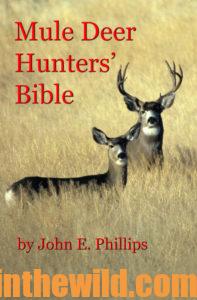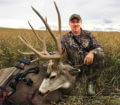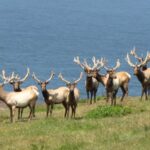Editor’s Note: Longtime, avid hunter Marshall Johnson of Bismarck, North Dakota, is the senior regional director for the Mule Deer Foundation https://muledeer.org/ that restores, improves and protects mule deer habitat, including land and easement acquisitions, and develops programs that help mule deer and black-tailed deer conservation. Mule deer and black-tailed deer live throughout western North America from the coastal islands of Alaska down the West Coast to southern Baja, Mexico, and from the northern border of the Mexican state of Zacatecas, up through the Great Plains to the Canadian provinces of Saskatchewan, Alberta, British Columbia and the southern Yukon Territory. Mule deer: are browsers with a majority of their diet weeds and leaves and twigs of woody shrubs; grow 3 to 3-1/2 feet tall and generally weigh 130-280 pounds; have a 310-degree view around themselves due to their eyes being located on the sides of their heads; can detect movement up to 1900+ feet away; and have a sense of smell 1,000 times stronger than a human’s. Marshall Johnson’s trophies are the lands he’s helped to open up that once were private and today have and are becoming public access for hunters.
A project I’m very interested in and have enjoyed participating in is collaring mule deer fawns. The Mule Deer Foundation is helping to fund and participate in a number of studies to help all of us learn more about mule deer, their growth and development and their movement patterns. One of the projects that a volunteer like me dreams about participating in happened last year. The Mule Deer Foundation received an Outdoor Heritage Fund grant of $475,000 from the State of North Dakota https://www.nd.gov/ndic/outdoor-infopage.htm, with monies received from the oil and gas industry. (This fund was established in 2013 as a multi-million dollar program to provide grants to state agencies, tribal governments, political subdivisions and nonprofit organizations, with higher priority given to projects that enhance conservation practices in North Dakota by: providing access to private and public lands for sportsmen; creating fish and wildlife habitat; improving, maintaining and restoring water quality, soil conditions, plant diversity and animal systems; and by supporting other practices of stewardship to enhance farming and ranching).
With the oil that has been discovered in the Bakken rock formation in North Dakota, Montana, Saskatchewan and Manitoba that’s a widespread prolific source rock for oil, as well as holding existing oil within the rock unit itself, the economy of North Dakota has been greatly improved by the revenues coming in from the oil industry. Of course, we don’t like to see any disruption in the land. The MDF reached out to the oil industry, sat down and visited with the folks involved and told them about the many MDF members and the oil industry’s employees – both men and women – who are very concerned with wildlife. We asked them to let the MDF help the oil industry mitigate some issues. We discovered that many of the oil companies were willing to give money back to better the habitat for wildlife.
 Also, one MDF chapter located in Fargo, N.D., is near the headquarters of the Bobcat Company https://www.bobcat.com/ that makes farm and construction equipment. Since we were able to bring the Bobcat Company into the fold, for the last 3 years, the Bobcat Company has donated use of their heavy equipment at no charge and the transportation of that equipment to sites where Mule Deer Foundation volunteers and the Game and Fish Department are working on major projects to improve mule deer habitat. This gesture by the Bobcat Company has saved the MDF and North Dakota’s Game and Fish Department thousands of dollars. In the last 3 years, the Bobcat Company has helped us out on two major projects. The oil companies working in North Dakota also have donated additional monies, besides the monies donated to the North Dakota Wildlife Heritage Fund, to help us improve the habitat for wildlife through a matching-funds program.
Also, one MDF chapter located in Fargo, N.D., is near the headquarters of the Bobcat Company https://www.bobcat.com/ that makes farm and construction equipment. Since we were able to bring the Bobcat Company into the fold, for the last 3 years, the Bobcat Company has donated use of their heavy equipment at no charge and the transportation of that equipment to sites where Mule Deer Foundation volunteers and the Game and Fish Department are working on major projects to improve mule deer habitat. This gesture by the Bobcat Company has saved the MDF and North Dakota’s Game and Fish Department thousands of dollars. In the last 3 years, the Bobcat Company has helped us out on two major projects. The oil companies working in North Dakota also have donated additional monies, besides the monies donated to the North Dakota Wildlife Heritage Fund, to help us improve the habitat for wildlife through a matching-funds program.
In one of the projects, the MDF worked with an older gentleman who had CRP land. The land came out of the CRP program, since he wasn’t planning to farm or lease that land. We introduced this gentleman to the PLOTS (Private Lands Open to Sportsmen) Program https://gf.nd.gov/plots/guide that the Game and Fish Department in North Dakota supports. This program lets a landowner put his land into the PLOTS Program, and then the public can hunt, fish and access this property, and the state will pay the landowner a certain amount of money per acre. The amount of revenue a landowner can receive is based on what all that landowner offers to the sportsmen.
 Around 2007 or 2008, the MDF started working with the State of North Dakota to identify locations and landowners who might be interested in putting their land into the PLOTS Program. The Mule Deer Foundation agreed to share in the costs that the state would incur for the annual leasing of those properties for public use. In 2014, we had approximately 20,000 acres that we helped sponsor in the PLOTS Program. By using the money the MDF raises, we help the state to increase the number of private properties that can be opened up to the sportsmen. So, the MDF is identifying new areas that never may have been hunted or fished before and helping to get public access to that land.
Around 2007 or 2008, the MDF started working with the State of North Dakota to identify locations and landowners who might be interested in putting their land into the PLOTS Program. The Mule Deer Foundation agreed to share in the costs that the state would incur for the annual leasing of those properties for public use. In 2014, we had approximately 20,000 acres that we helped sponsor in the PLOTS Program. By using the money the MDF raises, we help the state to increase the number of private properties that can be opened up to the sportsmen. So, the MDF is identifying new areas that never may have been hunted or fished before and helping to get public access to that land.
Along with the Outdoor Heritage Fund https://www.nd.gov/ndic/outdoor-infopage.htm, the Mule Deer Foundation has reached out to landowners – some of whom were affected by oil and gas leases – and talked with them. The MDF has offered to come out and work with them to improve their lands for wildlife. In return for our help to improve the land for wildlife, the MDF has asked the landowners to consider putting their properties in the PLOTS Program (Private Lands Open to Sportsmen) https://gf.nd.gov/plots/guide. This program is a win/win for everyone. When the MDF helps improve a landowner’s property, we also: improve its productivity; open up access to hunters, anglers and backpackers and other outdoor enthusiasts; improve the productivity of the wildlife using that land; and opened the door for the energy industry to join hands with the MDF in improving the properties that are a part of their businesses or adjacent to their businesses. Anyone who has a knowledge of conservation understands that conservation isn’t cheap. Someone has to pay some amount of money to improve habitat and wildlife.
 The first project was near Belfield where the MDF started plowing the land and seeding it with native grasses and forbs. In one year, there was a boom in the number of deer, elk and pheasants that started utilizing that land. The following year this same landowner came to us and said, “I’ve got another 180 acres to the north of the property you’ve just improved. Can we do the same type of project on that property?” The MDF’s answer was, “Sure.” Then the domino effect took place once more.
The first project was near Belfield where the MDF started plowing the land and seeding it with native grasses and forbs. In one year, there was a boom in the number of deer, elk and pheasants that started utilizing that land. The following year this same landowner came to us and said, “I’ve got another 180 acres to the north of the property you’ve just improved. Can we do the same type of project on that property?” The MDF’s answer was, “Sure.” Then the domino effect took place once more.
On some bigger properties that had so much potential for public access the MDF and the North Dakota Game and Fish will pull in other conservation organizations to help with the rehabilitation of this land, including the Rocky Mountain Elk Foundation (RMEF) https://www.rmef.org/; Pheasants Forever https://pheasantsforever.org/; and the National Wild Turkey Federation http://www.nwtf.org/.
 To learn more about hunting mule deer, go to John E. Phillips’ book, “Mule Deer Hunters’ Bible,” available in Kindle and print versions and including information from 30+ mule deer hunters, at https://www.amazon.com/dp/B07QHCLFYB.
To learn more about hunting mule deer, go to John E. Phillips’ book, “Mule Deer Hunters’ Bible,” available in Kindle and print versions and including information from 30+ mule deer hunters, at https://www.amazon.com/dp/B07QHCLFYB.










